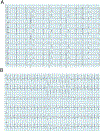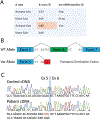Multicenter clinical and functional evidence reclassifies a recurrent noncanonical filamin C splice-altering variant
- PMID: 37164047
- PMCID: PMC10530503
- DOI: 10.1016/j.hrthm.2023.05.006
Multicenter clinical and functional evidence reclassifies a recurrent noncanonical filamin C splice-altering variant
Abstract
Background: Truncating variants in filamin C (FLNC) can cause arrhythmogenic cardiomyopathy (ACM) through haploinsufficiency. Noncanonical splice-altering variants may contribute to this phenotype.
Objective: The purpose of this study was to investigate the clinical and functional consequences of a recurrent FLNC intronic variant of uncertain significance (VUS), c.970-4A>G.
Methods: Clinical data in 9 variant heterozygotes from 4 kindreds were obtained from 5 tertiary health care centers. We used in silico predictors and functional studies with peripheral blood and patient-specific induced pluripotent stem cell-derived cardiomyocytes (iPSC-CMs). Isolated RNA was studied by reverse transcription polymerase chain reaction. iPSC-CMs were further characterized at baseline and after nonsense-mediated decay (NMD) inhibition, using quantitative polymerase chain reaction (qPCR), RNA-sequencing, and cellular electrophysiology. American College of Medical Genetics and Genomics (ACMG) criteria were used to adjudicate variant pathogenicity.
Results: Variant heterozygotes displayed a spectrum of disease phenotypes, spanning from mild ventricular dysfunction with palpitations to severe ventricular arrhythmias requiring device shocks or progressive cardiomyopathy requiring heart transplantation. Consistent with in silico predictors, the c.970-4A>G FLNC variant activated a cryptic splice acceptor site, introducing a 3-bp insertion containing a premature termination codon. NMD inhibition upregulated aberrantly spliced transcripts by qPCR and RNA-sequencing. Patch clamp studies revealed irregular spontaneous action potentials, increased action potential duration, and increased sodium late current in proband-derived iPSC-CMs. These findings fulfilled multiple ACMG criteria for pathogenicity.
Conclusion: Clinical, in silico, and functional evidence support the prediction that the intronic c.970-4A>G VUS disrupts splicing and drives ACM, enabling reclassification from VUS to pathogenic.
Keywords: Arrhythmia; Arrhythmogenic cardiomyopathy; Functional genetics; Nonsense-mediated decay; Splicing.
Copyright © 2023. Published by Elsevier Inc.
Conflict of interest statement
Figures





Comment in
-
Reclassifying variants in genes associated with arrhythmogenic cardiomyopathies.Heart Rhythm. 2023 Aug;20(8):1167-1168. doi: 10.1016/j.hrthm.2023.05.027. Epub 2023 May 27. Heart Rhythm. 2023. PMID: 37247683 No abstract available.
Similar articles
-
Reduction of Filamin C Results in Altered Proteostasis, Cardiomyopathy, and Arrhythmias.J Am Heart Assoc. 2024 May 21;13(10):e030467. doi: 10.1161/JAHA.123.030467. Epub 2024 May 18. J Am Heart Assoc. 2024. PMID: 38761081 Free PMC article.
-
Filamin-C variant-associated cardiomyopathy: A pooled analysis of individual patient data to evaluate the clinical profile and risk of sudden cardiac death.Heart Rhythm. 2022 Feb;19(2):235-243. doi: 10.1016/j.hrthm.2021.09.029. Epub 2021 Oct 1. Heart Rhythm. 2022. PMID: 34601126
-
Sudden cardiac death, arrhythmogenic cardiomyopathy and intercalated disc pathology due to reduced filamin C protein levels: a matter of life and death.Hum Mol Genet. 2025 Apr 6;34(8):726-738. doi: 10.1093/hmg/ddaf014. Hum Mol Genet. 2025. PMID: 39895064
-
Filamin C in cardiomyopathy: from physiological roles to DNA variants.Heart Fail Rev. 2022 Jul;27(4):1373-1385. doi: 10.1007/s10741-021-10172-z. Epub 2021 Sep 17. Heart Fail Rev. 2022. PMID: 34535832 Review.
-
A mutation update for the FLNC gene in myopathies and cardiomyopathies.Hum Mutat. 2020 Jun;41(6):1091-1111. doi: 10.1002/humu.24004. Epub 2020 Mar 20. Hum Mutat. 2020. PMID: 32112656 Free PMC article. Review.
Cited by
-
ParSE-seq: a calibrated multiplexed assay to facilitate the clinical classification of putative splice-altering variants.Nat Commun. 2024 Sep 27;15(1):8320. doi: 10.1038/s41467-024-52474-4. Nat Commun. 2024. PMID: 39333091 Free PMC article.
-
Reduction of Filamin C Results in Altered Proteostasis, Cardiomyopathy, and Arrhythmias.J Am Heart Assoc. 2024 May 21;13(10):e030467. doi: 10.1161/JAHA.123.030467. Epub 2024 May 18. J Am Heart Assoc. 2024. PMID: 38761081 Free PMC article.
References
Publication types
MeSH terms
Substances
Grants and funding
LinkOut - more resources
Full Text Sources
Medical

